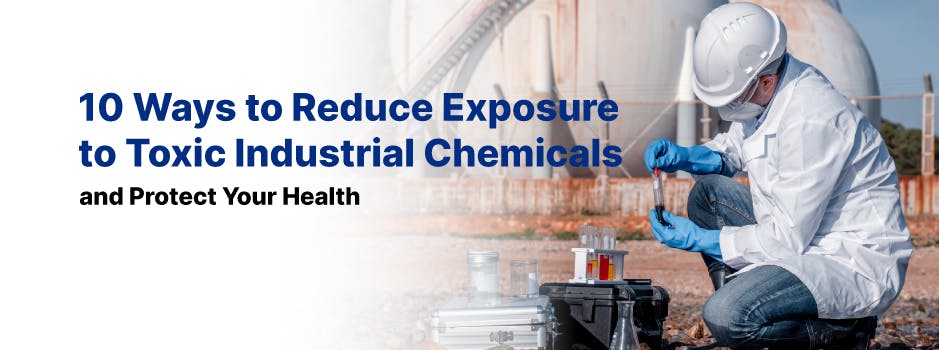Introduction
Toxic industrial chemicals are hazardous substances that are widely used in the manufacturing, transportation, and storage of various products. These chemicals pose significant health risks to workers, consumers, and the environment. Exposure to toxic industrial chemicals can lead to acute and chronic health effects, including respiratory problems, neurological damage, cancer, and reproductive disorders. In this blog, we will discuss the most common toxic industrial chemicals, their effects, and how to avoid them.
Common Toxic Industrial Chemicals
There are numerous toxic industrial chemicals, but we will focus on the most common ones.
- Benzene
Benzene is a highly flammable liquid with a sweet aroma that is used in the production of plastics, synthetic fibers, and rubber. Benzene is a known carcinogen that can cause leukemia and other cancers. Short-term exposure to benzene can cause dizziness, headaches, and vomiting.
- Formaldehyde
Formaldehyde is a colorless gas with a pungent odor that is used in the production of plastics, textiles, and cosmetics. Formaldehyde is a known carcinogen that can cause cancer of the nasopharynx, leukemia, and other cancers. Exposure to formaldehyde can also cause respiratory problems, skin irritation, and eye irritation.
- Lead
Lead is a heavy metal that is used in the production of batteries, paints, and ceramics. Lead exposure can cause brain damage, developmental delays, and anemia. High levels of lead exposure can also cause seizures, coma, and death.
- Asbestos
Asbestos is a naturally occurring mineral that was commonly used in insulation, roofing materials, and fireproofing. Asbestos exposure can cause lung cancer, mesothelioma, and other respiratory diseases. Asbestos-related diseases can take decades to develop, and symptoms may not appear until years after exposure.
- Polychlorinated Biphenyls (PCBs)
PCBs are synthetic chemicals that were commonly used in electrical equipment, such as transformers and capacitors. PCBs can cause liver damage, neurological damage, and reproductive problems. Exposure to PCBs can also increase the risk of cancer.
How to Avoid Toxic Industrial Chemicals
- Know the Chemicals
The first step in avoiding toxic industrial chemicals is to know what chemicals are in the products you use. Many products contain chemicals that are not listed on the label, so it is important to do research and read ingredient lists. You can also contact the manufacturer and ask for information about the chemicals in their products.
- Choose Safer Products
When possible, choose products that are labeled as "green" or "non-toxic." These products are less likely to contain hazardous chemicals. Look for products that are certified by independent organizations such as the Environmental Working Group (EWG) or the Green Seal.
- Avoid Chemicals in Food
Many toxic industrial chemicals can be found in food, particularly in meat and dairy products. Pesticides and herbicides can also contaminate fruits and vegetables. To reduce exposure to these chemicals, choose organic produce and grass-fed, hormone-free meat and dairy products.
- Properly Dispose of Chemicals
When you are finished with a product that contains hazardous chemicals, it is important to dispose of it properly. Many communities have hazardous waste collection days where you can dispose of these products safely. Do not pour chemicals down the drain or throw them in the trash.
- Use Protective Gear
If you work with hazardous chemicals, it is important to use protective gear, such as gloves, goggles, and respirators. These items can help prevent exposure to the chemicals.
- Proper Ventilation
If you work with hazardous chemicals in an enclosed space, it is important to ensure proper ventilation. Good ventilation helps to reduce the concentration of chemicals in the air, thereby reducing the risk of exposure.
- Stay Informed
Stay informed about the latest research and news regarding toxic industrial chemicals. There are numerous resources available, including government agencies such as the Environmental Protection Agency (EPA) and the Occupational Safety and Health Administration (OSHA), as well as non-governmental organizations such as the Environmental Defense Fund (EDF) and the Natural Resources Defense Council (NRDC).
- Reduce Chemical Use
Reduce your overall use of chemicals by opting for natural alternatives or by simply reducing your consumption of products that contain hazardous chemicals. For example, consider using natural cleaning products instead of chemical-based cleaners.
- Wash Your Hands
Frequent hand washing can help reduce the risk of exposure to toxic industrial chemicals. Wash your hands before and after handling products that contain hazardous chemicals, such as cleaning products or pesticides.
- Advocate for Change
Advocate for change by contacting your elected officials and urging them to support policies that promote safer products and reduce exposure to toxic industrial chemicals. You can also support organizations that work to promote safer products and reduce exposure to hazardous chemicals.
Conclusion
Toxic industrial chemicals significantly threaten human health and the environment. It is important to take steps to reduce exposure to these chemicals, including knowing the chemicals in the products you use, choosing safer products, avoiding chemicals in food, properly disposing of chemicals, using protective gear, ensuring proper ventilation, staying informed, reducing chemical use, washing your hands, and advocating for change. By taking these steps, we can reduce the risk of exposure to toxic industrial chemicals and protect our health and the health of the environment.

